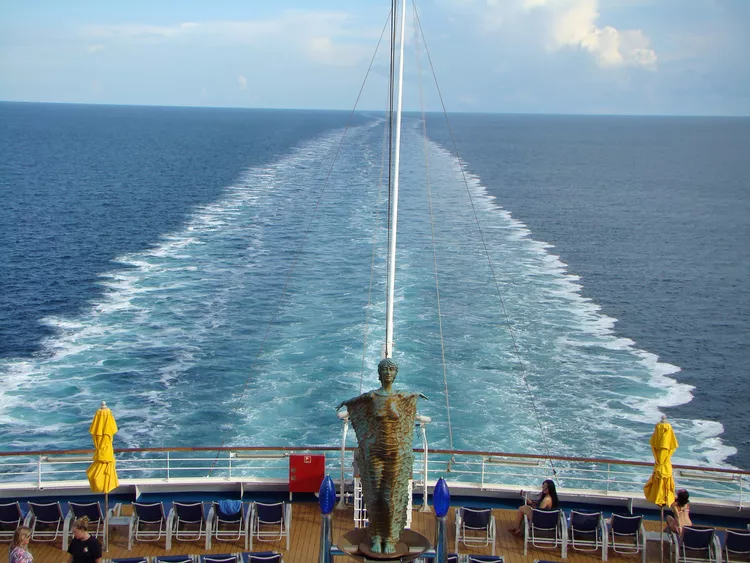Summary
Overpriced Shore Excursions
:max_bytes(150000):strip_icc():format(webp)/177242619-56ab0bae5f9b58b7d009379c.jpg)
This is potentially the largest single profit center for cruise lines today. While they arrange shore excursions for you, the price is often significantly higher than what you can arrange by simply stepping off the ship at the port and making a few inquiries.
If you prefer not to carry cash or negotiate with drivers or tour operators, paying the cruise line for excursions might be acceptable. However, some of the markups can be quite excessive.
Beware of Ship Photographers
:max_bytes(150000):strip_icc():format(webp)/cruise-camera-56ab09673df78cf772b4c419.jpg)
Upon disembarking at a new port, you will likely encounter a cruise line photography team at the entrance to capture this momentous occasion. This also applies to the captain’s welcome-aboard reception and even the safety drill.
Soon, you will find a “photo gallery” aboard the ship featuring you and the other passengers. Curiosity may compel you to spend several minutes searching through the hundreds of pictures. However, when you see the costs associated with these photos, you may think twice.
If one of these pictures captures a special moment, it’s worth purchasing. Nevertheless, those who feel that every moment the photographer captures is significant may end up spending considerably.
Beware of Art or Fashion Shows
:max_bytes(150000):strip_icc():format(webp)/cruise-fashionshow-56ab09653df78cf772b4c416.jpg)
Larger cruise lines often stage art or fashion shows on board, presenting what seems to be a genuine opportunity to view and purchase top-quality merchandise.
The challenge here is that most passengers may not understand the cost of the art or fashion in retail settings. Consequently, they might find themselves believing they are experiencing exclusive high-end shopping at sea.
While some genuine bargains may exist, it is essential to know what you are purchasing before being swept up in the moment.
Expensive Alcohol
:max_bytes(150000):strip_icc():format(webp)/cruise-bar-56ab09603df78cf772b4c413.jpg)
While beverages are generally not included in most cruise packages, there are rare all-inclusive cruises that cover these costs.
Each cruise line adopts different policies, yet many offer some version of a prepaid card for alcoholic and non-alcoholic beverages not covered in the package. These beverage cards, popular among passengers, can cost between $60-$80 per person and provide limited selections. It may also be possible to find cheaper cards for a small number of drinks.
Cruise lines typically permit passengers to bring a bottle of their own wine aboard for dinner, though a corkage fee may apply. Some guests attempt to smuggle spirits on board, but there’s a risk of confiscation if caught.
Ultimately, if you wish to consume anything beyond water, tea, or coffee on the cruise, it will come with a price tag – sometimes significantly. Consider checking if your cruise line allows you to stock your cabin with soft drinks from a nearby store upon embarkation.
Avoid the Casino
:max_bytes(150000):strip_icc():format(webp)/cruise-casino-56ab09635f9b58b7d00935b4.jpg)
In the interest of full disclosure, it should be noted that gambling isn’t for everyone; the entertainment value may seem limited for those watching their money disappear.
Unfortunately, the house tends to win, particularly on a cruise ship where frequent announcements of winners are common. However, for every fortunate winner, numerous players leave empty-handed.
Casinos typically operate once the ship is out of port and in international waters, creating busy periods during sea days when passengers might find themselves losing money.
Avoid Premium Dining
Meals are usually included in most cruise fares, making it an economical way to savor culinary experiences in expensive cities. By dining aboard the ship, travelers can avoid costly meals ashore.
Nevertheless, some cruise lines attempt to lure passengers into premium dining rooms, where elevated food quality comes with an additional payment. This can be an enticing option for special occasions like birthdays or anniversaries. However, one must be cautious; frequent visits to these premium dining venues can lead to a significant increase in expenses upon returning home.
Consider investigating these dining options as you finalize your cruise plans and establish a meal budget.
Resist Tipping Pressures
Tipping is vital on a cruise ship, as many staff members rely heavily on gratuities as part of their income structure.
If you receive outstanding service, it’s appropriate to tip accordingly. However, be wary of pressures regarding pre-determined gratuities, which are common in the industry. Cruise lines often impose a fixed tip amount on your onboard charge card, knowing that many travelers may overlook the chance to modify it while disembarking.
Some budget-conscious travelers prefer to start with no tip and adjust based on the level of service received. It’s wise to offer fair compensation, yet avoid succumbing to pressure for mediocre service.
Save Shopping for the Last Day
Most cruise ships feature at least one duty-free shop, showcasing a range of items from everyday necessities to apparel and swimwear.
While not everything may be overpriced, it’s beneficial to explore shopping options in ports of call before purchasing aboard the ship. You won’t fully appreciate available options if you shop at the beginning of your cruise.
Additionally, keeping purchases for the last day can yield potential sales and discounts. On one occasion, I discovered good deals on the final day of a trip that had not been offered previously.




